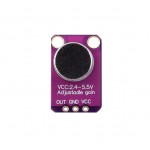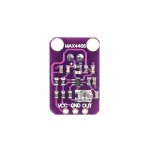Description:
This breakout is best used for projects such as voice changers, audio recording/sampling, and audio-reactive projects that use FFT. On the back, there is a small trimmer pot to adjust the gain. You can set the gain from 25x to 125x. That's down to be about 200mVpp (for normal speaking volume about 6" away) which is good for attaching to something that expects 'line level' input without clipping, or up to about 1Vpp, ideal for reading from a microcontroller ADC. The output is rail-to-rail so if the sound gets loud, the output can go up to 5Vpp!
How to use it: connect GND to ground, VCC to 2.4-5VDC. For the best performance, use the "quietest" supply available (on an Arduino, this would be the 3.3V supply). The audio waveform will come out of the OUT pin. The output will have a DC bias of VCC/2 so when it's perfectly quiet, the voltage will be a steady VCC/2 volts (it is DC coupled).
The output pin is not designed to drive speakers or anything but the smallest in-ear headphones - you'll need an audio amplifier (such as our 3.7W stereo amp) if you want to connect the amp directly to speakers. If you want to make it as a loudness sensor, just connect the OUT pin directly to the microcontroller ADC pin.
Specifications:
- Working Voltage: 2.4-5.5V
- Power Supply Rejection Ratio: 112dB
- Common Mode Rejection Ratio: 126dB
- AVOL: 12dB (RL=100kΩ)
- Quiescent Current: <24μA
- Gain Bandwidth: 600KHz
- Dimension: 20.8 x 13.8 x 7.5mm
- Weight: 1.8g
Links:




